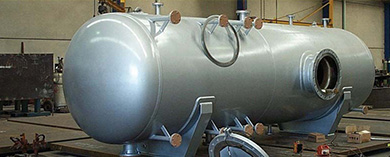
- (03) 5909 8218
- enquiry@fusionweld.com.au
Effects of Elevated Temperature in Pressure Vessels
June 23, 2016

Design engineers are tasked with multiple chores when pressure vessels are first conceived. The fluid contained within the sealed chamber is stored at some specified pressure, obviously, but there are other parameters to account for in the design. The chemical could be caustic, for example, capable of catastrophically reacting with a certain alloy, so material attributes have to be assessed. Similarly, temperature extremes occupy a crucial "maximum allowable" parameter as dictated by engineering specifications, but what happens if these carefully incorporated temperature boundaries are exceeded? Well, as with any causal loop, a damaged mechanical profile is the likely effect of this baking-hot cause.
Considering the Pressure-Temperature Relationship
Chemical facilities and heat exchangers employ highly energetic power sources to change the state of a fluid. Catalyzing agents and additives react to produce heat as a byproduct. Liquids flash and change form, transforming with some energy until the running liquid achieves its gaseous form. Now, in accordance with the laws of fluid dynamics, such energetic activities will cause particles to clash, which, in turn, causes a proportional rise in pressure. Weld seams and overall structural integrity must account for this relationship.
Thermal Fatigue Cracking
As cyclic changes occur due to expansion and contraction events, the design accommodates such mechanical fluctuations, but thermal fatigue is an entirely different matter. Pressure vessels are inherently rigid but a finite amount of elasticity is part of the structural makeup. Conversely, thermal stress works at a localized level, with the temperature gradient exposing different parts of the vessel surface to large temperature differentials. Microscopic flaws develop and become fine cracks, at which point the cracks propagate and vessel failure is possible.
Pressure Vessels Experience Cyclic Creep
Again, we're looking at a cycling action, the partnership of heat and pressure. In tandem, these two wearing forces cause the structural integrity of the vessel to deteriorate. The action, as the label suggests, is almost imperceptible. Long-term thermal exposure actually deforms the physical profile, thus mechanically crippling the fundamental strength of the container until its weakest spot, a weld seam or flange, gives way.
Elevated temperatures are a hazard, but they're usually unavoidable. Transient thermal spikes appear and vanish as quickly as they arrive, and we just design around such events. Special alloys offset thermal fatigue while allowable deformation properties account for creep. Alloys that incorporate nickel and chromium, for example, can deal with oxidation as well as all of the above thermal issues.
Contact Details
Fusion - Weld Engineering Pty Ltd
ABN 98 068 987619
1865 Frankston Flinders Road,
Hastings, VIC 3915
Ph: (03) 5909 8218
Optimized by NetwizardSEO.com.au
Recent Posts
- Compressed Hydrogen Storage Vessels: Material Selection, Design & Australian Standards
- Welding QA/QC in Oil & Gas Pressure Vessel Fabrication – Ensuring Code Compliance
- AS1210 vs ASME VIII Pressure Vessel Code: Key Differences for Australian Projects
- Mitigating Hydrogen-Induced Cracking in Pressure Vessels: Engineering and Material Strategies
- Storage Tank Solutions Australia: Field-Erected, Prefabricated & Self-Bunded Explained
- Reducing Environmental Risks: Self-Bunded Tanks in Australian Oil & Gas Operations
- Precision in Production: How Pressure Vessels Are Manufactured for Industrial Safety
- Shell & Tube Heat Exchangers: Improve Thermal Control & Energy Recovery in Petrochemical & Pharmaceutical Plants
- In-Service Inspection for Compressed Air Receivers for Power Plant Shutdown Prevention
- Power Plant Pipe Spooling Fabrication – Get Rapid, Code-Compliant Spools Ready for Installation
- Field Erected Tanks: Safe, Reliable On-Site Fuel Storage Solutions in Australia
- Custom Pressure Vessel Fabrication for Flammable Gases
Posts 2025
- Compressed Hydrogen Storage Vessels: Material Selection, Design & Australian Standards
- Welding QA/QC in Oil & Gas Pressure Vessel Fabrication – Ensuring Code Compliance
- View all articles…
Posts 2024
- Large Process Vessels: Optimising the Design for Maximum Efficiency [2025]
- Pressure Equipment Management System Installation: Detect Equipment Faults Early
- View all articles…
Posts 2023
- Pressure Piping System Inspection: A Gift of Safety for the Holidays
- Deaerator Inspections by Fusion-Weld Engineering and How They Reduce System Downtime
- View all articles…
Posts 2022
- How Fusion Weld Keeps Up With AS-NZS ISO 9001:2008 Standard
- Boiler Equipment Safety Inspection During the Summer Season
- View all articles…
Posts 2021
- Avoid These Factors and Practices that Contribute to Sealing Damage in Pressure Vessels
- Do's And Don'ts Of Industrial Boiler Inspection And Maintenance From Fusion-Weld
- View all articles…
Posts 2020
- What are the Risks and Hazards Involved in Pressure Vessel Equipment?
- How to Know if Your Pressure Equipment Needs Repair or Replacement?
- View all articles…
Posts 2019
- Factors that Contribute to Pressure Vessel Failure
- Pressure Vessel Regulations in Australia: What are the Mandatory Requirements?
- View all articles…
Posts 2018
- Pros and Cons of Spherical vs. Cylindrical Pressure Vessels
- What are the Different Hazard Levels in Pressure Vessels?
- View all articles…
Posts 2017
- Transportable Pressure Vessels: The Importance of Inspection and Safety Checks
- Fracture Mechanics and Stress Analysis of Cracks in Pressure Vessels
- View all articles…
Posts 2016
Posts 2015
- What Are Deaerators & Feedwater Vessels?
- Precautions and Safety for Compressed Air Receiver Vessels
- View all articles…
Posts 2014
- Demonstrating In-process Inspection Procedures
- Static Grounding Practices and Standards
- View all articles…